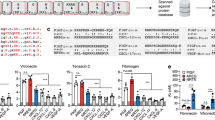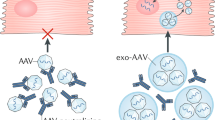Abstract
Systemic injection into blood vessels is the most common method of drug administration. However, targeting drugs to the heart is challenging, owing to its dynamic mechanical motions and large cardiac output. Here, we show that the modification of protein and peptide therapeutics with tannic acid—a flavonoid found in plants that adheres to extracellular matrices, elastins and collagens—improves their ability to specifically target heart tissue. Tannic-acid-modified (TANNylated) proteins do not adsorb on endothelial glycocalyx layers in blood vessels, yet they penetrate the endothelium to thermodynamically bind to myocardium extracellular matrix before being internalized by myoblasts. In a rat model of myocardial ischaemia-reperfusion injury, TANNylated basic fibroblast growth factor significantly reduced infarct size and increased cardiac function. TANNylation of systemically injected therapeutic proteins, peptides or viruses may enhance the treatment of heart diseases.
This is a preview of subscription content, access via your institution
Access options
Access Nature and 54 other Nature Portfolio journals
Get Nature+, our best-value online-access subscription
$29.99 / 30 days
cancel any time
Subscribe to this journal
Receive 12 digital issues and online access to articles
$99.00 per year
only $8.25 per issue
Buy this article
- Purchase on Springer Link
- Instant access to full article PDF
Prices may be subject to local taxes which are calculated during checkout







Similar content being viewed by others
References
Maeda, H., Nakamura, H. & Fang, J. The EPR effect for macromolecular drug delivery to solid tumors: improvement of tumor uptake, lowering of systemic toxicity, and distinct tumor imaging in vivo. Adv. Drug Deliv. Rev. 65, 71–79 (2013).
Rozema, D. B. et al. Dynamic polyconjugates for targeted in vivo delivery of siRNA to hepatocytes. Proc. Natl Acad. Sci. USA 104, 12982–12987 (2007).
Akinc, A. et al. Development of lipidoid–siRNA formulations for systemic delivery to the liver. Mol. Ther. 17, 872–879 (2009).
Kaczmarek, J. C. et al. Polymer–lipid nanoparticles for systemic delivery of mRNA to the lungs. Angew. Chem. Int. Ed. 128, 14012–14016 (2016).
Khan, O. F. et al. Dendrimer-inspired nanomaterials for the in vivo delivery of siRNA to lung vasculature. Nano Lett. 15, 3008–3016 (2015).
Shimizu, T., Yamato, M., Kikuchi, A. & Okano, T. Cell sheet engineering for myocardial tissue reconstruction. Biomaterials 24, 2309–2316 (2003).
Nelson, D. M., Ma, Z., Fujimoto, K. L., Hashizume, R. & Wagner, W. R. Intra-myocardial biomaterial injection therapy in the treatment of heart failure: materials, outcomes and challenges. Acta Biomater. 7, 1–15 (2011).
Hamdi, H. et al. Cell delivery: intramyocardial injections or epicardial deposition? A head-to-head comparison. Ann. Thorac. Surg. 87, 1196–1203 (2009).
Miyagi, Y. et al. Biodegradable collagen patch with covalently immobilized VEGF for myocardial repair. Biomaterials 32, 1280–1290 (2011).
Nelson, D. M. et al. Intramyocardial injection of a synthetic hydrogel with delivery of bFGF and IGF1 in a rat model of ischemic cardiomyopathy. Biomacromolecules 15, 1–11 (2014).
Martens, T. P. et al. Percutaneous cell delivery into the heart using hydrogels polymerizing in situ. Cell Transplant. 18, 297–304 (2009).
Hao, X. et al. Angiogenic effects of sequential release of VEGF-A165 and PDGF-BB with alginate hydrogels after myocardial infarction. Cardiovasc. Res. 75, 178–185 (2007).
Scott, R. C., Crabbe, D., Krynska, B., Ansari, R. & Kiani, M. F. Aiming for the heart: targeted delivery of drugs to diseased cardiac tissue. Expert Opin. Drug Deliv. 5, 459–470 (2008).
Wang, Z. et al. Adeno-associated virus serotype 8 efficiently delivers genes to muscle and heart. Nat. Biotechnol. 23, 321–328 (2005).
Mayer, C. R. & Bekeredjian, R. Ultrasonic gene and drug delivery to the cardiovascular system. Adv. Drug Deliv. Rev. 60, 1177–1192 (2008).
Dvir, T. et al. Nanoparticles targeting the infarcted heart. Nano Lett. 11, 4411–4414 (2011).
Beeri, R. et al. New efficient catheter-based system for myocardial gene delivery. Circulation 106, 1756–1759 (2002).
Weinbaum, S., Tarbell, J. M. & Damiano, E. R. The structure and function of the endothelial glycocalyx layer. Annu. Rev. Biomed. Eng. 9, 121–167 (2007).
Pelouch, V., Dixon, I. M. C., Golfman, L., Beamish, R. E. & Dhalla, N. S. Role of extracellular matrix proteins in heart function. Mol. Cell. Biochem. 129, 101–120 (1994).
Dai, J. & Mumper, R. J. Plant phenolics: extraction, analysis and their antioxidant and anticancer properties. Molecules 15, 7313–7352 (2010).
Sileika, T. S. et al. Colorless multifunctional coatings inspired by polyphenols found in tea, chocolate, and wine. Angew. Chem. Int. Ed. 52, 10766–10770 (2013).
Ejima, H. et al. One-step assembly of coordination complexes for versatile film and particle engineering. Science 341, 154–157 (2013).
Shin, M. et al. DNA/tannic acid hybrid gel exhibiting biodegradability, extensibility, tissue adhesiveness, and hemostatic ability. Adv. Funct. Mater. 25, 1270–1278 (2015).
Khan, N. S., Ahmad, A. & Hadi, S. M. Anti-oxidant, pro-oxidant properties of tannic acid and its binding to DNA. Chem. Biol. Interact. 125, 177–189 (2000).
Shukla, A., Fang, J. C., Puranam, S., Jensen, F. R. & Hammond, P. T. Hemostatic multilayer coatings. Adv. Mater. 24, 492–496 (2012).
Van Buren, J. P. & Robinson, W. B. Formation of complexes between protein and tannic acid. J. Agric. Food Chem. 17, 772–777 (1969).
Heijmen, F. H., Du Pant, J. S., Middelkoop, E., Kreis, R. W. & Hoekstra, M. J. Cross-linking of dermal sheep collagen with tannic acid. Biomaterials 18, 749–754 (1997).
Shin, M., Kim, K., Shim, W., Yang, J. W. & Lee, H. Tannic acid as a degradable mucoadhesive compound. ACS Biomater. Sci. Eng. 2, 687–696 (2016).
Ma, S., Lee, H., Liang, Y. & Zhou, F. Astringent mouthfeel as a consequence of lubrication failure. Angew. Chem. Int. Ed. 128, 5887–5891 (2016).
Siebert, K. J., Troukhanova, N. V. & Lynn, P. Y. Nature of polyphenol−protein interactions. J. Agric. Food Chem. 44, 80–85 (1996).
Bate-Smith, E. C. Haemanalysis of tannins: the concept of relative astringency. Phytochemistry 12, 907–912 (1973).
Chung, J. E. et al. Self-assembled micellar nanocomplexes comprising green tea catechin derivatives and protein drugs for cancer therapy. Nat. Nanotech. 9, 907–912 (2014).
Mero, A., Ishino, T., Chaiken, I., Veronese, F. M. & Pasut, G. Multivalent and flexible PEG-nitrilotriacetic acid derivatives for non-covalent protein pegylation. Pharm. Res. 28, 2412–2421 (2011).
Torchilin, V. P. Micellar nanocarriers: pharmaceutical perspectives. Pharm. Res. 24, 1–16 (2007).
Sonavanea, G., Tomoda, K. & Makino, K. Biodistribution of colloidal gold nanoparticles after intravenous administration: effect of particle size. Colloids Surf. B Biointerfaces 66, 274–280 (2008).
Papadopoulou, A., Green, R. J. & Frazier, R. A. Interaction of flavonoids with bovine serum albumin: a fluorescence quenching study. J. Agric. Food Chem. 53, 158–163 (2005).
Yokoyama, M. et al. Toxicity and antitumor activity against solid tumors of micelle-forming polymeric anticancer drug and its extremely long circulation in blood. Cancer Res. 51, 3229–3236 (1991).
Isenburg, J. C., Simionescu, D. T. & Vyavahare, N. R. Elastin stabilization in cardiovascular implants: improved resistance to enzymatic degradation by treatment with tannic acid. Biomaterials 25, 3293–3302 (2004).
Isenburg, J. C., Simionescu, D. T. & Vyavahare, N. R. Tannic acid treatment enhances biostability and reduces calcification of glutaraldehyde fixed aortic wall. Biomaterials 26, 1237–1245 (2005).
Lu, Y. & Bennick, A. Interaction of tannin with human salivary proline-rich proteins. Arch. Oral Biol. 43, 717–728 (1998).
Weber, L., Kirsch, E., Moller, P. & Krieg, T. Collagen type distribution and macromolecular organization of connective tissue in different layers of human skin. J. Invest. Dermatol. 82, 156–160 (1984).
Green, R. J. et al. Surface plasmon resonance analysis of dynamic biological interactions with biomaterials. Biomaterials 21, 1823–1835 (2000).
Poncet-Legrand, C., Gautier, C., Cheynier, V. & Imberty, A. Interactions between flavan-3-ols and poly(l-proline) studied by isothermal titration calorimetry: effect of the tannin structure. J. Agric. Food Chem. 55, 9235–9240 (2007).
Frazier, R. A., Papadopoulou, A., Mueller-Harvey, I., Kissoon, D. & Green, R. J. Probing protein–tannin interactions by isothermal titration microcalorimetry. J. Agric. Food Chem. 51, 5189–5195 (2003).
Frasca, V. Biophysical characterization of antibodies with isothermal titration calorimetry. J. Appl. Bioanal. 2, 90–102 (2016).
Hong, H. S. et al. A new role of substance P as an injury-inducible messenger for mobilization of CD29+ stromal-like cells. Nat. Med. 15, 425–435 (2009).
Hearse, D. J. & Bolli, R. Reperfusion induced injury: manifestations, mechanisms, and clinical relevance. Cardiovasc. Res. 26, 101–108 (1992).
Sides, G. D. QT interval prolongation as a biomarker for torsades de pointes and sudden death in drug development. Dis. Markers 18, 57–62 (2002).
Hondeghem, L. M., Carlsson, L. & Duker, G. Instability and triangulation of the action potential predict serious proarrhythmia, but action potential duration prolongation is antiarrhythmic. Circulation 103, 2004–2013 (2001).
Pacher, P., Nagayama, T., Mukhopadhyay, P., Bátkai, S. & Kass, D. A. Measurement of cardiac function using pressure–volume conductance catheter technique in mice and rats. Nat. Protoc. 3, 1422–1434 (2008).
Weiss, J. L., Frederiksen, J. W. & Weisfeldt, M. L. Hemodynamic determinants of the time-course of fall in canine left ventricular pressure. J. Clin. Invest. 58, 751–760 (1976).
Zhu, F. et al. New findings on the effects of tannic acid: inhibition of L-type calcium channels, calcium transient and contractility in rat ventricular myocytes. Phytother. Res. 30, 510–516 (2016).
Park, J. H. et al. A cytoprotective and degradable metal–polyphenol nanoshell for single-cell encapsulation. Angew. Chem. Int. Ed. 53, 12420–12425 (2014).
Awada, H. K. et al. A single injection of protein-loaded coacervate-gel significantly improves cardiac function post infarction. Biomaterials 125, 65–80 (2017).
Chu, H., Chen, C.-W., Huard, J. & Wang, Y. The effect of a heparin-based coacervate of fibroblast growth factor-2 on scarring in the infarcted myocardium. Biomaterials 34, 1747–1756 (2013).
Jang, J.-H. et al. An evolved adeno-associated viral variant enhances gene delivery and gene targeting in neural stem cells. Mol. Ther. 19, 667–675 (2011).
Acknowledgements
This work was supported by a grant from the National R&D Program for Cancer Control, Ministry for Health and Welfare, Republic of Korea (1631060 to H.L.). This work was also supported by a National Research Foundation of Korea (NRF) grant funded by the Ministry of Science, ICT and Future Planning for the following convergent research: a development programme for convergence research and development in traditional culture and current technology (NRF-2016M3C1B5906485 to H.L.), the Mid-career Researcher Program (NRF-2017R1A2A1A05001047 to H.L.) and the Basic Science Research Program funded by the Ministry of Education (NRF-2016R1A6A3A11933589 to M.S.). Further support was provided by the Technology Innovation Program (an establishment of risk management platform with the aim of reducing the attrition of new drugs and services) funded by the Ministry of Trade, Industry and Energy (10067737 (K.-S.K.)). The authors also thank B. S. Choi and H. N. Kim for advice on the ITC experiments.
Author information
Authors and Affiliations
Contributions
M.S. conceived and designed the experiments. M.S., H.-A.L., M.L., D.-H.N. and S.H.P. performed the in vivo experiments on heart accumulation, cardiotoxicity and therapeutic efficacy for the MIR disease model. Y.S. and J.-J.S. prepared the GFP. E.J.J. performed the in vitro experiments for SP. M.C. prepared the AAV9-encoding GFP. M.D. prepared the AAV2-encoding GFP. M.S., H.-A.L., S.-W.K., S.-W.C., M.S.L., J.-H.J., K.-S.K. and H.L. discussed and interpreted the results. M.S., H.-A.L. K.-S.K and H.L. wrote the paper. M.S., H.L. and K.-S.K. supervised the project.
Corresponding authors
Ethics declarations
Competing interests
The authors declare no competing interests.
Additional information
Publisher’s note: Springer Nature remains neutral with regard to jurisdictional claims in published maps and institutional affiliations.
Supplementary information
Supplementary Information
Supplementary figures and tables.
Rights and permissions
About this article
Cite this article
Shin, M., Lee, HA., Lee, M. et al. Targeting protein and peptide therapeutics to the heart via tannic acid modification. Nat Biomed Eng 2, 304–317 (2018). https://doi.org/10.1038/s41551-018-0227-9
Received:
Accepted:
Published:
Issue Date:
DOI: https://doi.org/10.1038/s41551-018-0227-9
This article is cited by
-
Intra-articular injection of stigmasterol-loaded nanoparticles reduce pain and inhibit the inflammation and joint destruction in osteoarthritis rat model: A pilot study
Drug Delivery and Translational Research (2024)
-
Engineering protein-based therapeutics through structural and chemical design
Nature Communications (2023)
-
Advanced micro-/nanotechnologies for exosome encapsulation and targeting in regenerative medicine
Clinical and Experimental Medicine (2023)
-
Tannic acid assisted anti-TNF-α nanobody assembly modulating the epithelial barrier dysregulation of allergic rhinitis
Nano Research (2023)
-
Biomimetic anti-inflammatory and osteogenic nanoparticles self-assembled with mineral ions and tannic acid for tissue engineering
Nano Convergence (2022)



